Counterfeit Carseats Are Here: Are These Flimsy Carseats Safe?

![]()
![]()
![]()
![]()
![]()
Save Your Money and Avoid Knockoff Carseats
 How do you know you can use a carseat safely for your child? Cheap (and not-so-cheap) Chinese carseats sold in the U.S., and caregivers buying items not certified for use here, have created a market where unscrupulous sellers have swooped in with vastly inferior, and sometimes fake, products. Keep reading to find out how to identify a carseat that’s not certified for use in the U.S. or that’s potentially dangerous to use.
How do you know you can use a carseat safely for your child? Cheap (and not-so-cheap) Chinese carseats sold in the U.S., and caregivers buying items not certified for use here, have created a market where unscrupulous sellers have swooped in with vastly inferior, and sometimes fake, products. Keep reading to find out how to identify a carseat that’s not certified for use in the U.S. or that’s potentially dangerous to use.
How Do You Know If A Carseat Is Fake or Not Certified for Use in the U.S.?
Let’s start at the surface of these carseats—they’re easy to spot, actually. The U.S. requires a registration card to be attached to the harness on the front of the carseat. This is to prompt you to fill out your information and send it back to the manufacturer so they can notify you of any recall that may occur. If it’s missing, it’s a red flag that something is amiss with the carseat—either it’s a return, the card was never placed on the harness in the first place, or the carseat isn’t certified for use in the U.S.

Required Text on Labels
Labels on carseats are also required to have a lot of specific text and occasionally a diagram. Plus, you will see the manufacturer’s name boldly printed or stitched onto the cover—they want you, and everyone else, to know who made your carseat. Fake carseats don’t have manufacturer names on them.
Let’s look at the airbag warning labels parents love to hate. The label on carseat A is all pictograms, so it doesn’t meet U.S. standards. The label on the carseat B has lots of warning text in two languages, so you know it meets U.S. standards. Are there labels on carseat C? (Hint: no.)
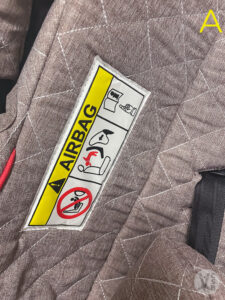


Carseat A is labeled for use in Europe, carseat B is a Graco SnugRide SnugFit 35 (a U.S. carseat), and carseat C is fake.
This next label is the most important one. The KEY WORDING you will want to look for is this bit: ‘‘This child restraint system conforms to all applicable Federal motor vehicle safety standards.’’ It immediately precedes the red text “This Restraint is Certified for Use in Motor Vehicles.” (and Aircraft, if applicable.)

If the carseat does not have this wording on the side, it does not meet U.S. safety standards and cannot be legally used.
Manufacturers must make sure their carseats meet the requirements laid out in Federal Motor Vehicle Safety Standard (FMVSS) 213. If even one word on a label does not meet capitalization or font size requirements, a recall will be issued. Canada has their standards (CMVSS 213) and Europe (E.U.) has theirs (ECE R44/04 and UN R129). Canadian standards align closely with American standards, though there are some differences.
European standards do differ from American standards, especially in the labeling. China doesn’t release much information about their standards, but they do base them on E.U. safety standards.
Carseats that meet other countries’ standards have one of the following labels on them. If the carseat has the label on it, it’s not legal to use in the U.S. Only carseats with the above label with red text are legal to use in the U.S., though a couple models may have the Canadian maple leaf label on them as well since their manufacturers have either harmonized the labeling between our two countries or dual certified them for use in both countries.





Carseats can be manufactured very cheaply in China for many off-name brands around the world for less than what it costs to put a tank of gas into a compact car.
These carseats and strollers are flooding the U.S. market. Parents are buying them because they like the look of the stroller and the carseat is a bonus, or feel the price is right and think that because these items are being sold here, they must be safe to use and that’s not always the case.
To be fair, many legitimate and safe carseats are made in China. Manufacturers keep costs down and carseats accessible to everyone by making carseats in China, though many very expensive carseats are manufactured there too. The difference is that the manufacturers who make their carseats conform to FMVSS 213 standards have quality assurance standards in place and, at least prior to COVID, made factory visits to ensure strict production guidelines were being met.
However, the more these carseats that are not legal to use in the U.S. continue to compete with sales of legitimate carseats, the more the market is diluted and caregivers won’t know which carseats are legal and safe to use and which are not. It’s akin to the fake news problem we now have: where do you go if you don’t know who to believe—and some of these carseats have labeling that are very similar to name brands. We’ve reached a whole new level of buyer beware.
Non-U.S./Canadian Carseats Don’t Have A Chest Clip
Why? European standards—specifically ECE R44/04, which expires at the end of August 2024—require caregivers to be able to release the child from the carseat in one motion. Actually, FMVSS 213—remember, that’s the U.S. safety standard all carseats must pass—does NOT require a chest clip. The manufacturer may require its use as a function of the carseat’s safety, but our national standards don’t require it. A chest clip’s purpose is to keep the harness on a child’s shoulders. Carseat A doesn’t have a chest clip. Carseat B does. Carseat C does not have a chest clip.
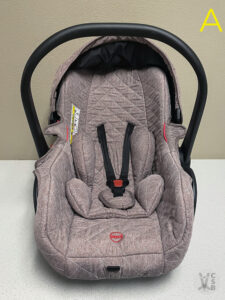
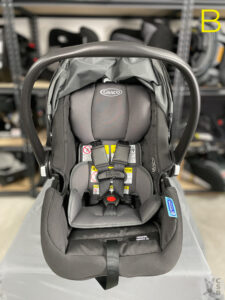

Harness Design: 3-Point Harness vs. 5-Point Harness
The harness is narrower on European regulated seats than U.S. carseats: 25 mm (approx. 1”) to the 1.5” required on U.S. seats. The buckle also has a different design, called a compound buckle to aid in a one-handed release.



As of this writing, all U.S. carseats have 5-point harnesses (with the exception of some special needs carseats), which means they have shoulder straps, hip straps, and a crotch strap. Many Euro carseats have 3-point harnesses, which have a Y shape: they don’t have hip straps.





Other Labeling
The labels are vastly different. The U.S. requires all kinds of labels everywhere on the carseat and they MUST HAVE TEXT on them. Carseats with Euro labeling (meeting ECE R44/04 and R129 requirements) have mostly pictograms. That does not mean the U.S. labels do not have diagrams on them—most do!
Notice carseat A has an orange ECE R44/04 certification label on it while carseat C has no labels on it other than two that say, “BELT HERE.” It’s pretty clear that carseat C is what we consider to be a counterfeit carseat. The orange label on carseat A also tells us that the certifying body is a microstate in Europe called San Marino. I Google-Mapped it and it’s in Italy. I don’t want to throw shade at San Marino, but it’s not France or Germany or Sweden (or Italy!) when it comes to certification purposes and we’ve seen their label on a few suspect carseats like this one here.





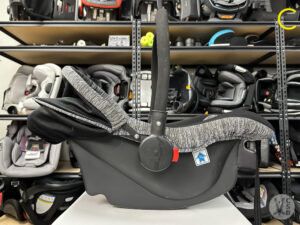

Weights
Weights are listed in kilograms (kgs.) versus pounds (lbs.). We sure tried in the 1970s, but we did not convert the country over to the metric system the rest of the world uses so our carseat labels show pounds. If you have to use an app to convert your child’s weight to see if you can still safely use their carseat, your carseat does not meet U.S. safety requirements.
Manuals/Language
Manuals and labels contain grammatically incorrect English. If you struggle to understand what has been written or you laugh at a roughly translated sentence, chances are that carseat is not certified to use in the U.S. Though I do have to admit I have read manuals from some FMVSS 213-certified carseats that needed several more rounds of editing before reaching the printing stage!
Website
Don’t fall for scary website tactics and buzz words like “BPA, PVC, phthalate, and lead free.” The webmaster put these words on the website to take advantage of first-time parents who don’t know the meaning of these words and where these substances are found. One website also says that the stroller wheels are “explosion-proof.” OK, really? Really??? I also love this “bionic” seat. I’m not sure what reaction other than laughter that miscommunication should evoke.

Which Companies Are Verified Carseat Manufacturers?
I’m glad you asked. There are lists! SafeRideNews, which is a nonprofit organization that all CPSTs know about has a page on their website with links to 3 lists: the JPMA list and the CR Manufacturers List have the same info but in a different layout, so choose whichever you like better. The Vehicle manufacturers list is a freebie list. This is a great overall page to bookmark!
Which Retailers Should We Avoid?
MaternityMiracles.com is under active investigation and sells their products from a UPS Store in Carson City, NV. Take a close look at their product page. It shows several pictures of a rear-facing only carseat with base, which as a consumer, you’d assume is allowed for use in the U.S. In the description, however, it says that the carseat is not federally approved (of course it’s not—the base doesn’t have a belt path nor is the harness wide enough). This is deceptive advertising.
Another retailer is steanny.com. On their product pages, they admit to meeting FMVSS 213, which is a lie. Again, the base doesn’t have a required belt path and the harness doesn’t meet the required 1.5” width. This is deceptive advertising.
Amazon still sells these travel systems too. It’s like playing Whac-a-Mole: you report one listing and another pops up. All we can do is educate caregivers not to purchase off-brand baby gear.


What Other Carseats Are Counterfeit/Fake?
The ones we see a lot are the fake Doona carseat and strollers. Doonas are expensive at $550 and don’t go on sale often—a legitimate boutique baby store may discount a particular color by 10% because of overstock. If you see a Doona for less than $550, question whether it’s real and the retailer is legitimate.

We’ve also seen an influx of travel vests that have hit the market this year. The only crash-tested, FMVSS-213-certified safe travel vest is the Ride Safer Travel Vest. It looks like this:

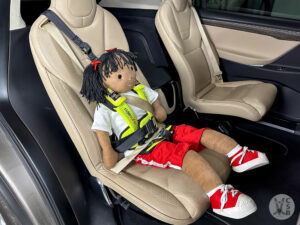
These others are dangerous.


Why Should You Care?
Baby stuff is expensive. Here at CSB, we’ve all had to pay for diapers, clothing, safety supplies, feeding supplies, carseats, and more. Shouldn’t we try to save money where we can? Not with safety items. There’s a difference between cheap and inexpensive and this, friends, is where we define that line.
We have no idea of the manufacturing processes or quality controls such as flame retardancy (either natural or added) and plastic engineering (these carseats and their parts are flimsy!). The two unbranded carseats featured here do not meet U.S. standards.
Is There Recourse?
What about the sellers? What is their liability in selling carseats to unsuspecting parents and caregivers? This is an interesting question that I posed to an investigator in my state by way of filing a complaint. Because it’s so easy to buy these travel systems cheaply and turn around to sell them for 10-15 times profit, the people selling these carseats don’t necessarily know they can be dangerous. They’re relying on the factory, which has most likely stolen a patented design (e.g., all of the fake Doona carseat strollers that are out there) or CAD-designed one to meet their “customers’” needs.
The investigator who followed up on my complaint—and he had to do quite a lot of digging to find this information—said that the owner of the internet company selling the travel systems out of a UPS Store P.O. box claimed he was completely unaware of the danger. He hasn’t taken the stock offline yet, so we’ll see where it all lands, but it really leads back to parents and caregivers needing to do their homework in making sure that what they purchase online is safe to use.
To report an uncertified or fake carseat, see if your state’s attorney general’s office has a form to fill out. You can also go to stopfakes.gov and send an email.


Don’t be sucked in by the picture of the cute mama with the kicky foot or knee pop and do not bury your head in the “I’m a first-time parent so I don’t know anything” sand. Be a smart consumer! Some of you research your dinner more than you are researching some of the baby items you are buying and these are items designed to keep your child safe. The Internet that brings us these fake carseats and strollers also brings us the ability to find great legitimate carseats. If you’re unsure which website to use, we can help. We have to be smart consumers to keep the demand for these cheap, fake carseats out of the U.S. market.
🌟 Photos of carseat A provided by my good friend, Xochitl Kambak. She encountered it while doing a carseat checkup appointment for a family. It’d be hard to have this article without them, so thanks, Xoch!







